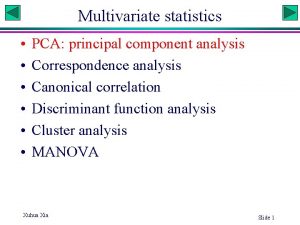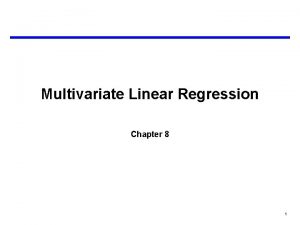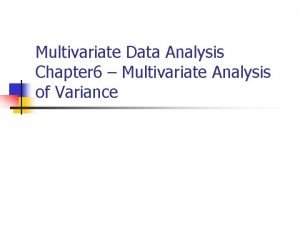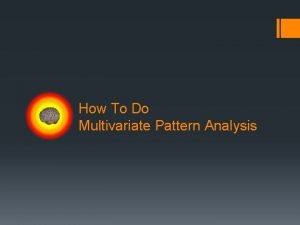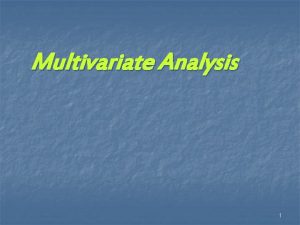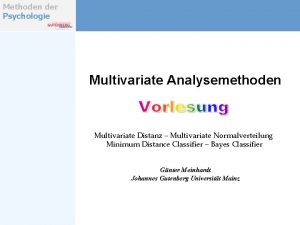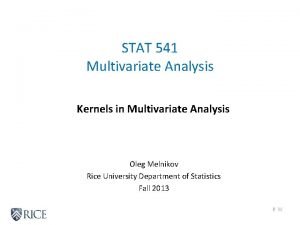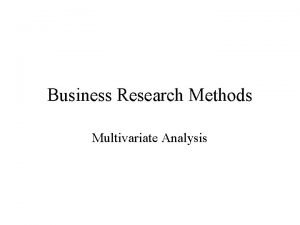Multivariate Analysis Introduction What is Multivariate Analysis The








- Slides: 8

Multivariate Analysis Introduction

What is Multivariate Analysis? The expression multivariate analysis is used to describe analyses of data that have numerous variables or where observations are obtained for each individual or unit studied. In a typical survey 30 to 100 questions are asked to each respondent. For example, in describing the financial status of a company, an investor may wish to examine five to ten measures of the company's performance. Commonly, the answers to some of these measures are interrelated. The challenge of disentangling complicated interrelationships among various measures on the same individual or unit and of interpreting these results is what makes multivariate analysis a rewarding activity for the investigator. Often results can not be attained without multivariate analysis.

What is Multivariate Analysis? Multiple Regression Analysis Multiple regression is a statistical technique through which one can analyze the relationship between a dependent or criterion variable and a set of independent or predictor variables. As a statistical tool, multiple regression is often used to accomplish three objectives: 1. To find the best prediction equation for a set of variables, that is, given X 1, X 2, …, Xn (the predictors), what is Y (the criterion variable)? 2. To control for confounding factors in order to assess the contribution of a specific variable or set of variables, that is, identifying independent relationships. 3. To find structural relationships and provide explanations for seemingly complex multivariate relationships.

What is Multivariate Analysis? Measure of Reliability The reliability of a measuring instrument is defined as the ability of the instrument to measure consistently the phenomenon it is designed to assess. Reliability, therefore, refers to test consistency. It is very common in business research to collect multiple measures of the same construct. For example, in a questionnaire designed to measure optimism, there are typically many items that collectively measure the construct of optimism. To have confidence in a measure such as this, we need to test its reliability, the degree to which it is error-free. The type of reliability we'll be examining here is called internal consistency reliability.

What is Multivariate Analysis? Factor analysis Factor Analysis is a set of techniques used for understanding variables by grouping them into “factors” consisting of similar variables. An investigator has asked each respondent in a survey whether he or she: strongly agrees, is undecided, disagrees, or strongly disagrees with 15 statements concerning attitudes toward inflation. As a first step, the investigator will do a factor analysis on the resulting data to determine which statements belong together in sets that are uncorrelated with other sets. The particular statements that form a single set will be examined to obtain a better understanding of attitudes toward inflation. Scores derived from each set or factor will be used in subsequent analysis to predict consumer spending.

What is Multivariate Analysis? Canonical Discriminant Analysis for Classification and Prediction The basic purpose of discriminant analysis is to estimate the relationship between a single nonmetric (categorical) dependent variable and a set of metric independent variables in this general form: YI = Xl + X 2 + X 3 +. . . + Xn (nonmetric) (metric) The major application area for this technique is where we want to be able to distinguish between two or more sets of objects or people, based on the knowledge of some of their characteristics. Examples include the selection process for a job, the admission process of an educational program in a college, or dividing a group of people into potential buyers and non-buyers.

What is Multivariate Analysis? Cluster Analysis Cluster analysis is a group of multivariate techniques whose primary purpose is to group objects based on the characteristics they possess. It has been referred to as Q analysis, typology construction, classification analysis, and numerical taxonomy. This variety of names is due to the usage of clustering methods in such diverse disciplines as psychology, biology, sociology, economics, engineering, and business. Although the names differ across disciplines, the methods all have a common dimension: classification according to relationships among the objects being clustered. If clusters are formed of customers similar to one another, then cluster analysis can help marketers identify segments (clusters). For example, if clusters of brands are formed, this can be used to gain insights into brands that are perceived as similar to each other on a set of attributes.

What is Multivariate Analysis? Conjoint Analysis Conjoint analysis is a multivariate technique developed specifically to understand how respondents develop preferences for any type of object (products, services, or ideas). It is based on the simple premise that consumers evaluate the value of an object by combining the separate amounts of value provided by each attribute. For example, conjoint analysis is used to capture the exact levels of utility that an individual customer puts on various attributes of the product offering. It enables a direct comparison between say, the utility of a price level of $400 versus $500, a delivery period of 1 week versus 2 weeks, or an after sales response of 24 hours versus 48 hours.




